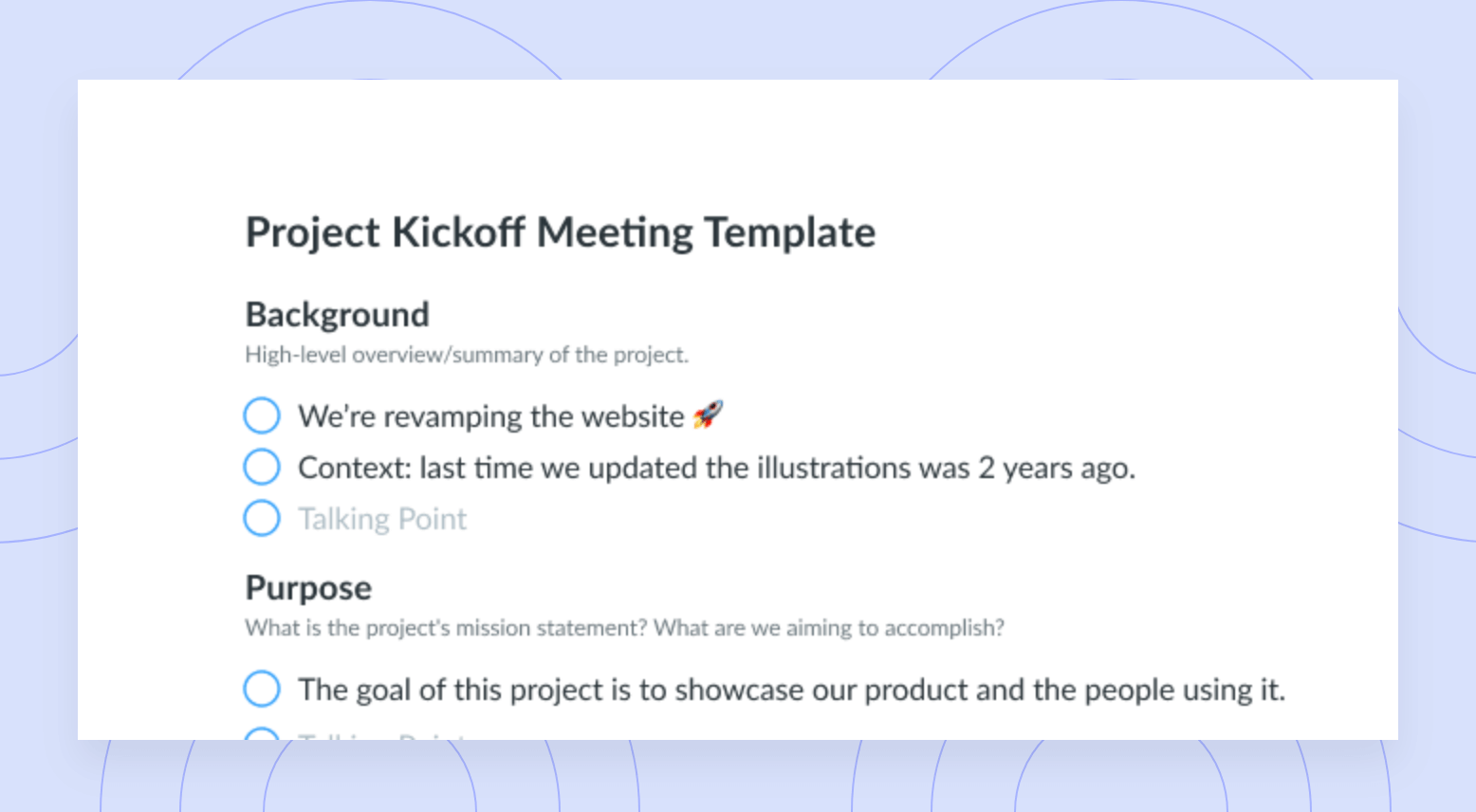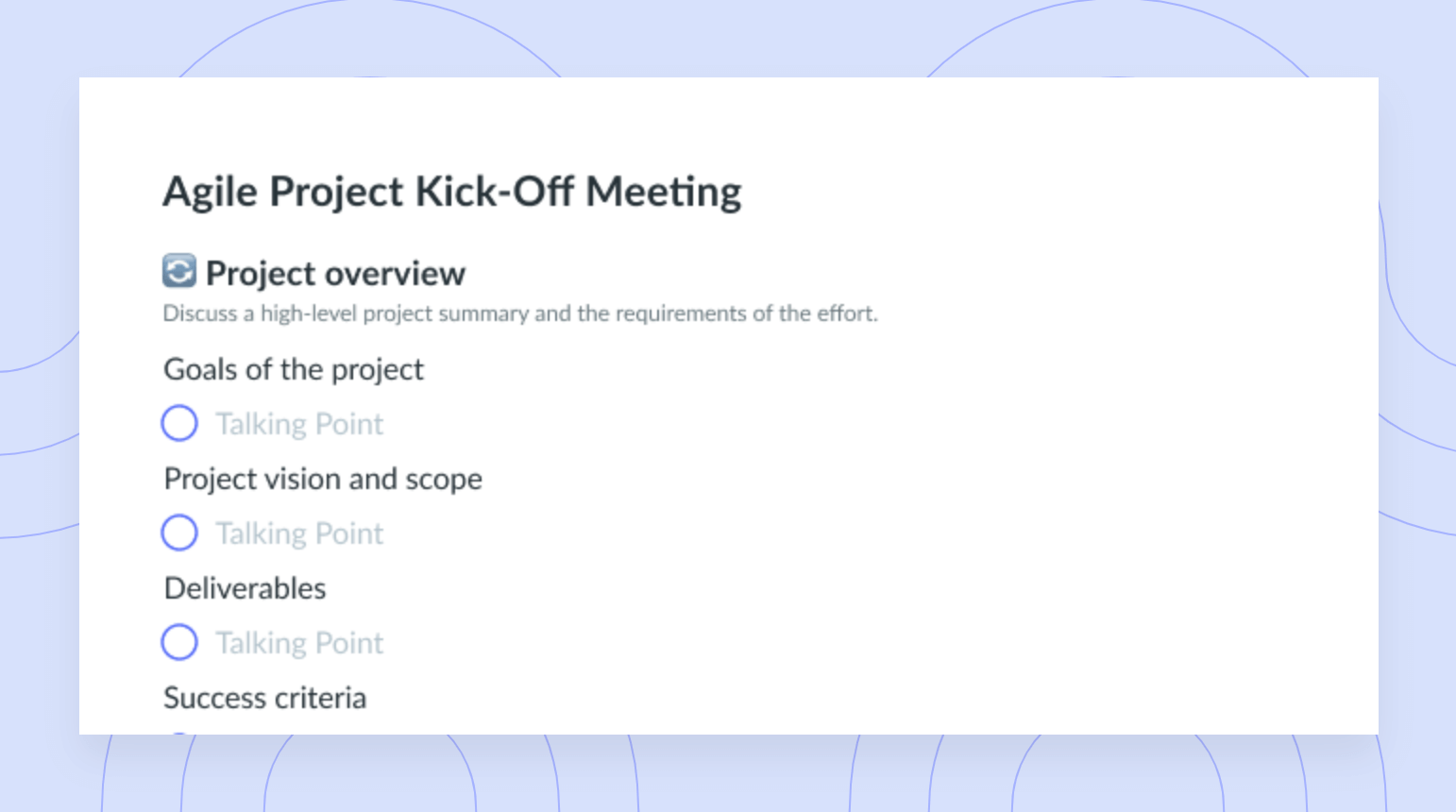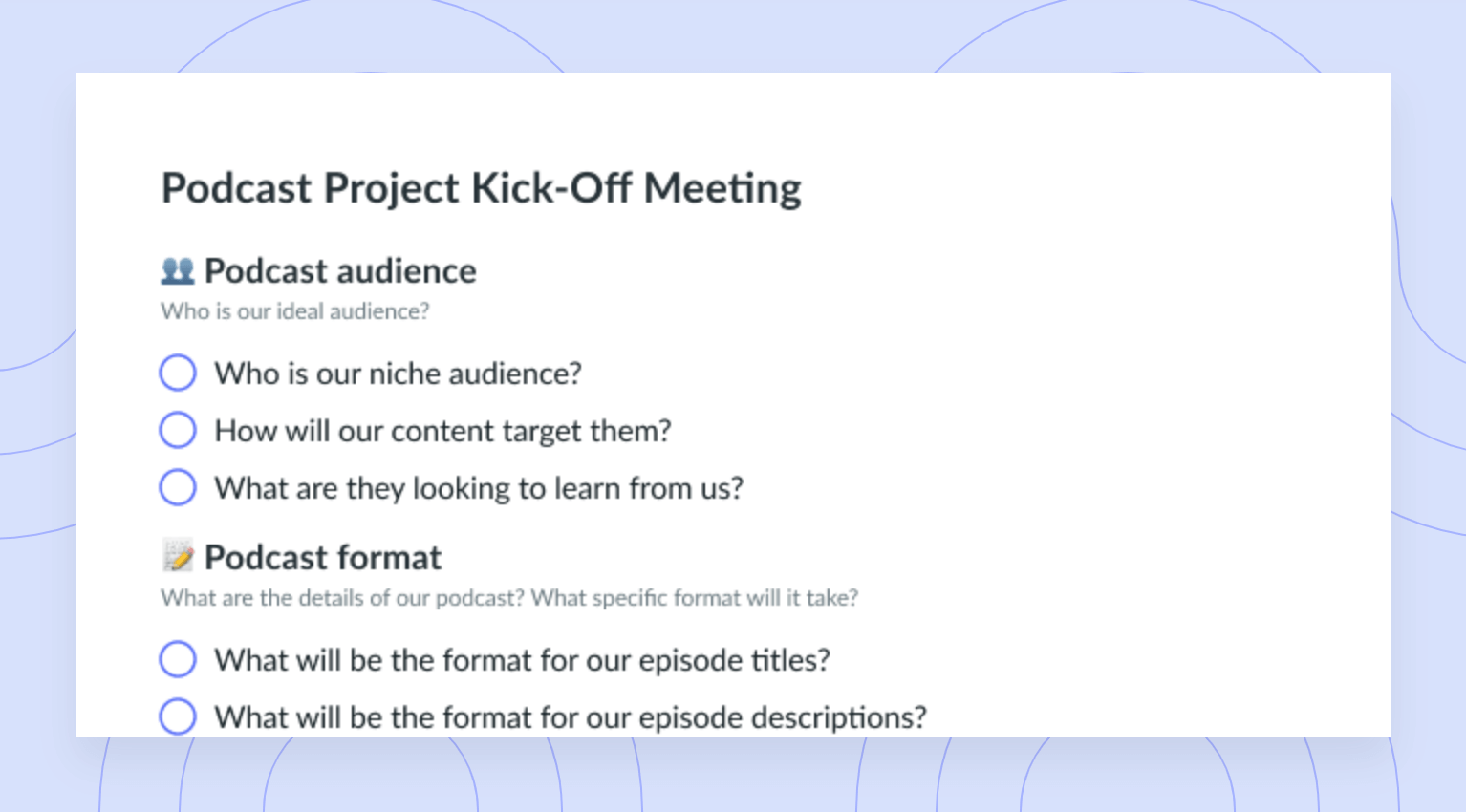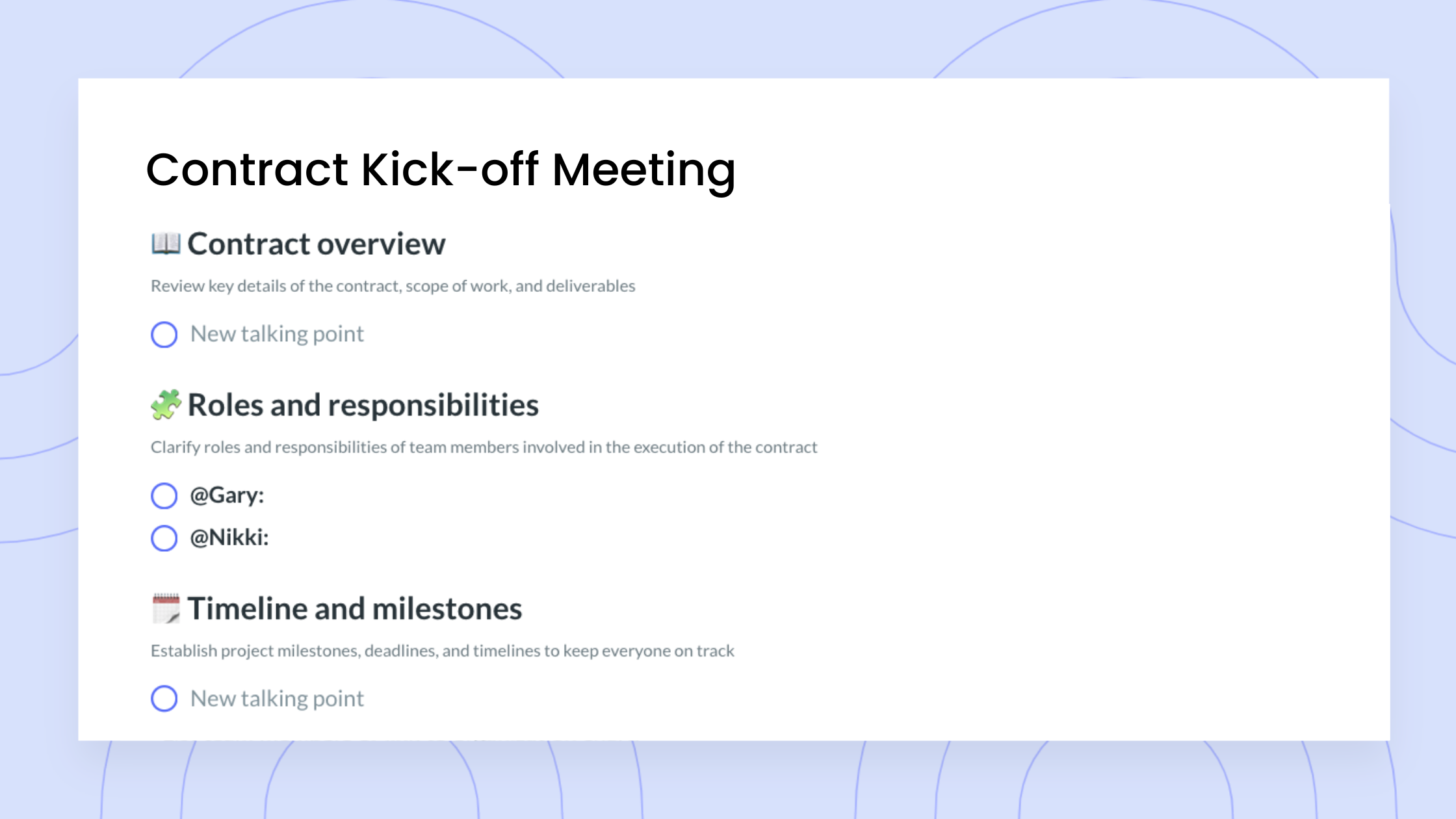11 Steps to Master Project Execution (+ Free Templates)
Seamless project execution is crucial for achieving project success. Discover how to create a flawless project execution plan with our comprehensive guide.
A new project is coming up, and you want your team to execute it in the best way possible. Before you jump in, it’s time to create a clear plan for putting your project into motion and ensuring it delivers the expected results. As you plan for successful project execution, you’ll focus on achieving objectives, collaborating, and managing resources.
- What is project execution?
- Why is monitoring the project execution phase important?
- Elements of a project execution plan
- How to create a project execution plan
- Best tools to implement your project execution plan
- Common challenges during project execution
- From planning to execution with Fellow
What is project execution?
Project execution is the third stage (following project initiation and planning) of the project management process—it’s when your plans become reality. After laying out project objectives and steps during the planning stage, the focus shifts to action.
Project execution involves coordinating resources, managing tasks, and hitting project milestones on time. If you accomplish goals and create quality deliverables smoothly, you’re doing project execution the right way.

Execute your projects seamlessly
Streamline your project meetings with Fellow: the all-in-one meeting transcription and management software for remote and hybrid teams. Give teams the right context, action items, and meeting automations to increase productivity. Stop letting bad meetings slow you down, try Fellow’s AI Meeting Copilot for free today!

Why is monitoring the project execution phase important?
When monitoring the execution phase in project management, you make sure everything is running on schedule and on budget. You can also better manage project complexity while adjusting to keep your team on track.
Monitoring the project execution phase allows you to catch risks—such as dwindling resources or expanding project scope—that could throw your project off course. You’ll find and address issues before they cause big-time problems.
Elements of a project execution plan
A detailed project execution plan (PEP) tells everyone, from team members to stakeholders, what’s coming throughout your project. It includes all the below parts.
- Project scope
- Quality standards
- Goal statements
- Resource allocation
- Project schedule
- Organizational components
Project scope
The project scope lays out everything included in your project—including objectives and key results (OKRs), tasks, resources, and limitations. You’ll define your project team members’ roles and their responsibilities. You’ll also consider the clients or stakeholders your project will impact so you can tailor your plans appropriately.
Quality standards
Everyone’s vision of a successful project might be a little different, but quality standards help everyone agree on what you’re working toward. Setting realistic standards keeps your team motivated and makes you all more likely to do great work consistently. Get peer feedback on these standards as you work through your project—what once seemed realistic might not be as you keep going.
Goal statements
Goal statements give your project clear direction and purpose. They dive into the small details of what you want to pull off during project execution while grounding all your executive decision-making meetings.
If someone suggests an idea that doesn’t align with your goal statements, you can set it aside for later. Spelling out what your project aims to achieve helps you organize everyone’s efforts and prioritize tasks.
Resource allocation
Resource allocation is about determining who and what you need for a successful project. You’ll name the people, budget, equipment, and time needed to achieve your project goals. You’ll also figure out how to distribute these resources so everything runs smoothly and you minimize waste.
Project schedule
The project schedule is the “when” of your project. It’s key to organizing and prioritizing work, keeping your project on track, and meeting deadlines.
Your project schedule lays out the sequences and deadlines for project activities. Some tasks will need to be completed before your team can start on others. Great project scheduling means keeping task dependencies in mind and creating a realistic timeline for completing everything.
Organizational components
This PEP element outlines how your team operates. It clarifies who’s in charge of what and details your communication channels. This way, team members know whom to go to for reporting progress, asking questions, or raising issues. Well-written organizational components ensure nothing falls through the cracks and create smooth, efficient workflows.
With all-in-one meeting management software like Fellow, you won’t have to worry about anything getting lost throughout the process. Your entire meeting workflow—even accessing video calls—is centralized in Fellow. With 50+ native integrations with productivity and project management tools, Fellow ensures that information is easily accessible, always synced, and up to date in one functional hub.
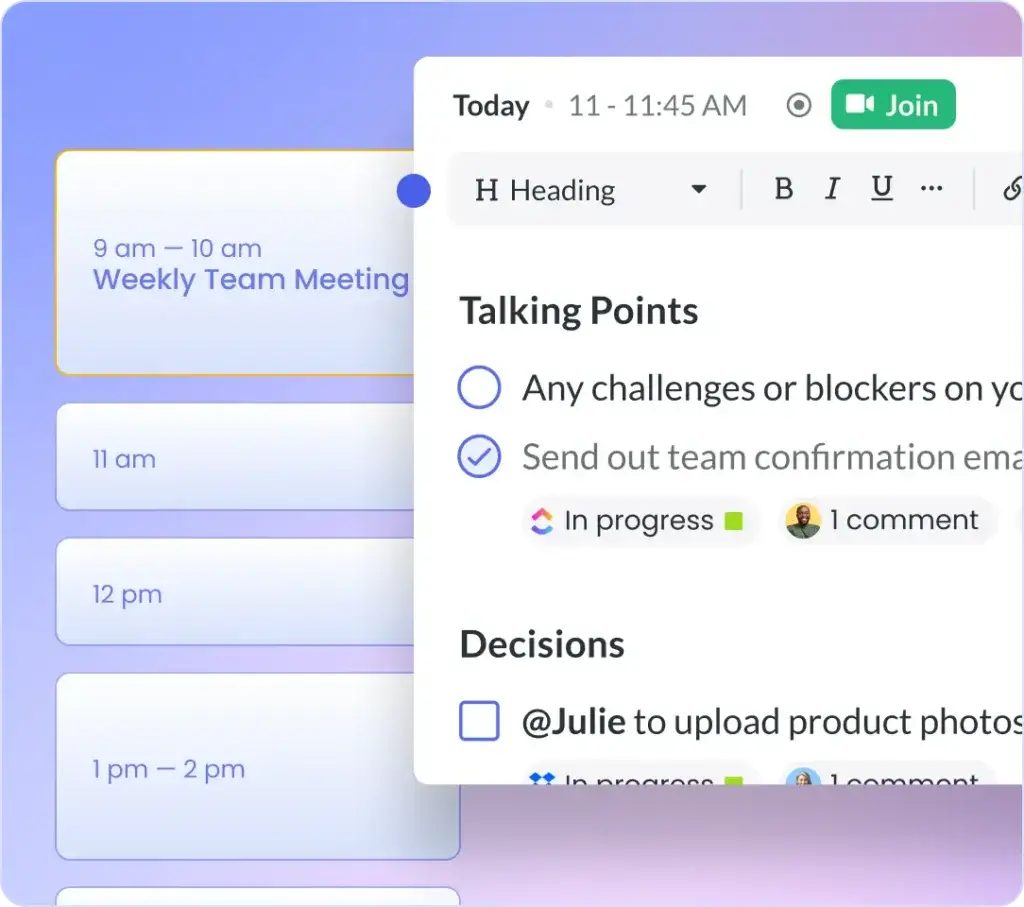
How to create a project execution plan
Now that you know what goes into a PEP, here’s exactly how to craft one.
- Define the project objectives
- Make sure your plan is feasible
- Know who your key stakeholders are
- Set a project scope
- Create a work breakdown structure
- Make a project timeline
- Allocate resources
- Assess risks
- Decide how you’ll monitor progress
- Refine the project execution plan
- Kick off the team
1Define the project objectives
The first step in creating a project execution plan is setting clear, achievable objectives using the SMART goals framework. Think about the exact outcomes you want to see by the end of your project. Then, appoint a project manager who will give your team ample direction for moving forward.
2Make sure your plan is feasible
Before diving into detailed planning, consider the time, money, and skills your project will require. Before proceeding, be confident that your organization is fully equipped to take on the project and produce exceptional results.
3Know who your key stakeholders are
Think about everyone who has an interest in your project or whom it will affect. These stakeholders include project sponsors, investors, customers, and team members. Bring in ideas and goals from all these groups so you can be sure your project meets their needs.
4Set a project scope
Transform your stakeholders’ feedback, your organization’s goals, and your project objectives into a document that unites all these themes. Be clear about your expectations for success and your project’s deliverables. This way, you reduce the chance of your project scope expanding and ensure everyone is on the same page.
5Create a work breakdown structure
A work breakdown structure (WBS)—you guessed it—breaks down your project into manageable tasks. Start with your larger project deliverables and split them into smaller tasks or even smaller subtasks. Doing so gives you a clear overview of your project’s components and dependencies while helping you transition right into scheduling.
6Make a project timeline
Create a project schedule that lays out the timeline and order of activities for completing your project. This schedule should factor in the key milestones, task dependencies, and deadlines from your WBS. You should also list the resources you need and when you need them to meet your project deliverables effectively and on time. If it fits the nature of your project, consider using a workback schedule to ensure the entire team stays on track and delivers on time.
7Allocate resources
Every part of your project requires some type of resource, whether it’s hardware, software, physical space, communication tools, or money. Distribute each of your resources to the teams, project phases, or tasks where they belong. This way, you get a better idea of whether there are enough resources to go around or you need to get more.
8Assess risks
Sometimes, taking a risk is a bold move that can work out in your favor. At other times, you want to avoid risks as much as possible. High costs, depleted resources, and scope creep are examples of risks that pop up during project management execution. Think about these risks in advance and create project execution strategies to move your team around these obstacles if they arise.
9Decide how you’ll monitor progress
Create a plan to hold regular check-ins with your team so you have all the latest progress updates. Setting targets for key performance indicators (KPIs) can be a great way to measure progress and show how well the project is advancing. From there, you can compare your KPIs, project progress, and target timeline to see how closely your team is hitting your marks.
Just as important as monitoring progress is reporting it to everyone involved in your project. Decide how often you’ll share updates with stakeholders and how you’ll communicate this information. Sometimes a simple email does the trick, and at other times a formal report is necessary. Ask your stakeholders what they prefer and why to inform your decision.
10Refine the project execution plan
Your PEP is pretty important—it’ll be your guide to working through your project smoothly and successfully. Thoroughly review it and make any necessary changes to cover everything properly. Ask for feedback from your team and stakeholders to get everyone’s input. Regularly get this feedback so you can be confident your PEP remains realistic and meaningful.
10Kick off the team
Once you’ve refined your project execution plan and received everyone’s buy-in, it’s time to brief the team and kick the plan into action. The best way to do this is by holding a meeting with all key project members, so everyone can get aligned in one go.
Unsure what to include in your meeting agenda? Fellow’s got you covered with over 500+ expert-approved meeting templates you can use.
To brief the team on project execution, leverage Fellow’s Project Kick-Off Meeting Agenda Template, 5Ws & 2Hs Project Kick-off Meeting Template from FINEOS’ VP of Program Management, or Engineering Project Kick-Off Meeting Template based on preference or project type.
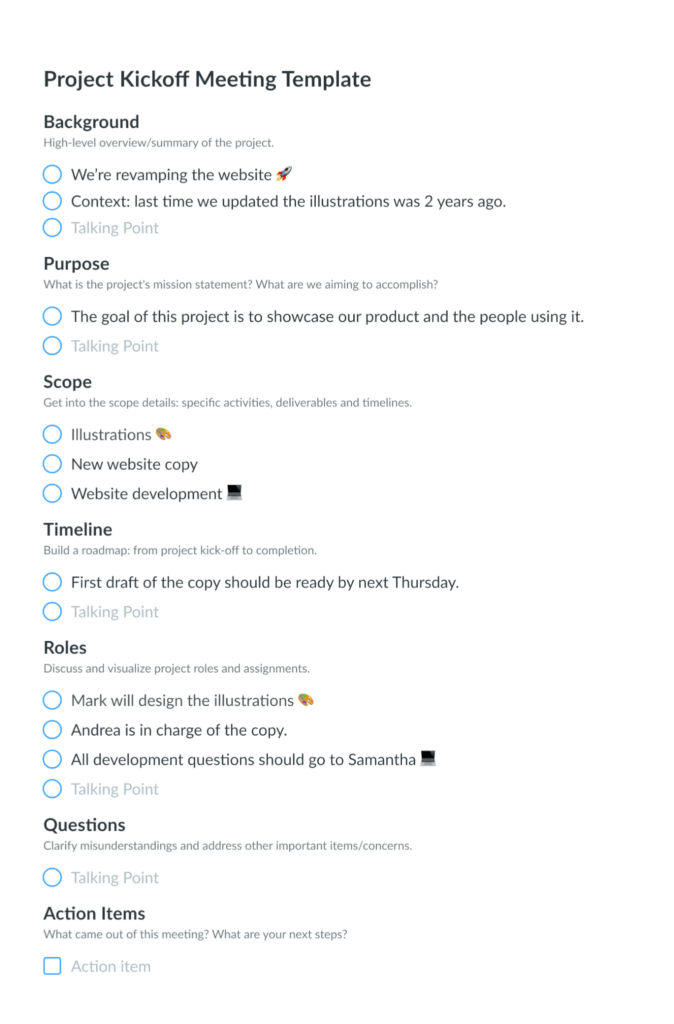
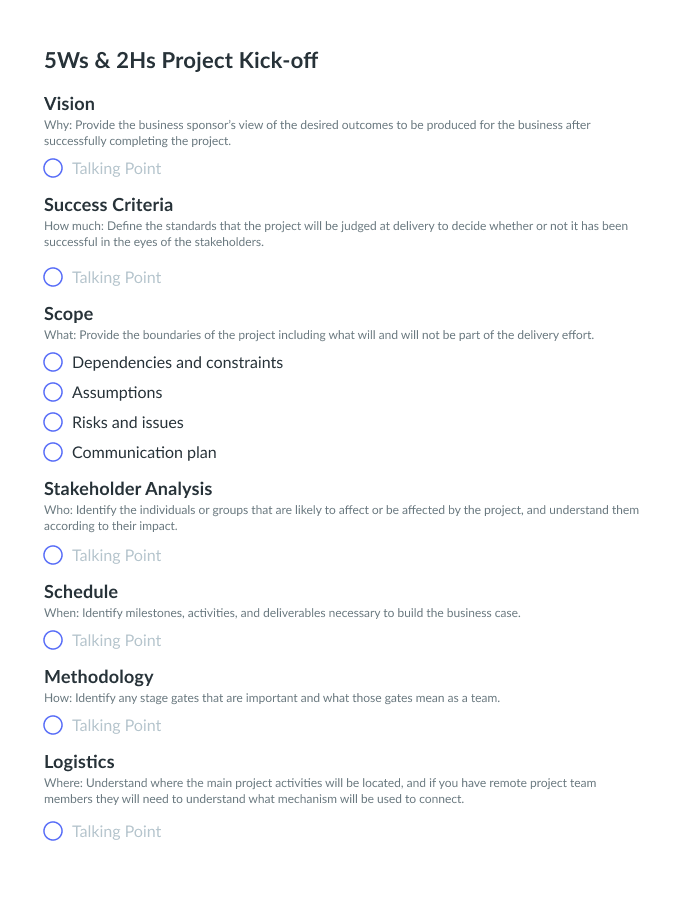
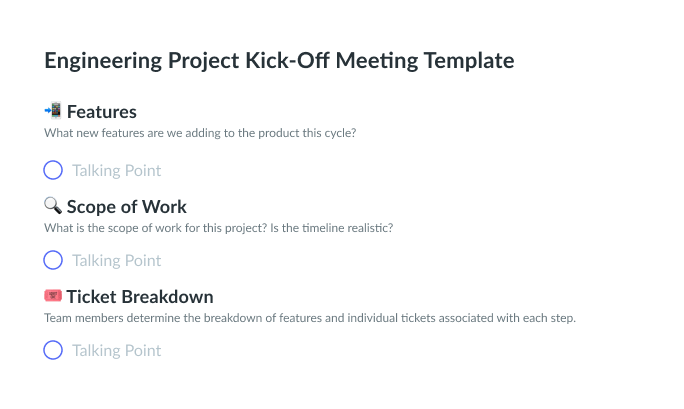
Best tools to implement your project execution plan
Project management tools can streamline your team’s work processes and enhance collaboration. Here are some options to consider.
Fellow
From crafting your project execution plans to preparing your project kick-off meeting agendas, Fellow is the only all-in-one AI meeting transcription and management software for remote and hybrid teams that can help you execute your projects seamlessly.
The collaborative meeting agenda feature allows you and your entire team to contribute to the discussion, and ensure everyone shows up to project meetings prepared. If you don’t want to start from scratch, Fellow has over 500+ meeting agenda templates you can use to host effective project meetings.
After each project meeting, Fellow’s action items feature enables you to assign, visualize, prioritize, and track all project tasks with ease. These action items seamlessly integrate with your favorite project management tools, making sure everything is aligned and up to date across your workflow.
Fellow even has an objectives and key results tool, which can help you and your team measure and track progress on the project objectives and goals!
Plus, you can even schedule Fellow’s AI Meeting Copilot to join each project meeting and automate outcomes based on the conversation. It’ll automatically record, transcribe and summarize the meeting, capturing an accurate record of discussions for all project stakeholders to reference.
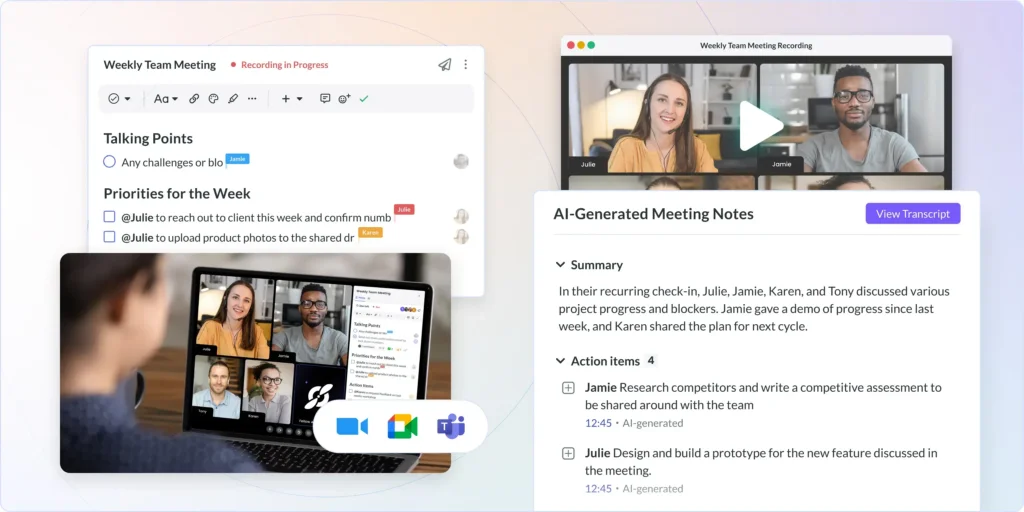
ProofHub
ProofHub makes managing tasks, coordinating with team members, and sharing ideas much easier. Its project management features include custom workflows, real-time reporting, and client request forms for considering new work. Collaboration is also core to ProofHub—it’s a channel for all your teamwork and communication, from one-on-one chats to group discussions.
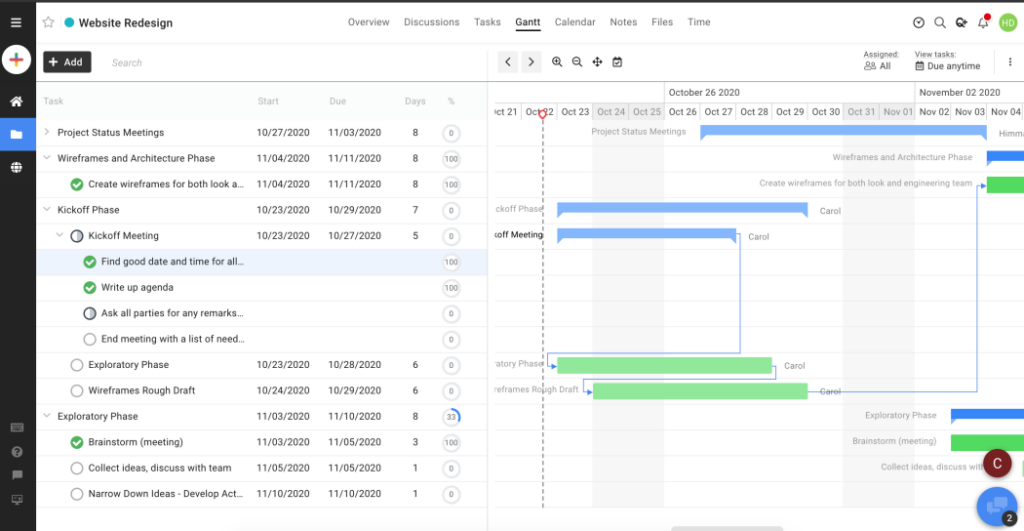
Kanban Tool
Kanban Tool is a visual project management system that helps you effectively manage tasks and workflows. It uses Kanban boards, cards, and columns to represent tasks and their statuses. Your teams can easily track their work, pinpoint bottlenecks, and prioritize tasks for seamless project execution. Kanban Tool also allows multiple team members to work on a board at a time so that work statuses are always current.
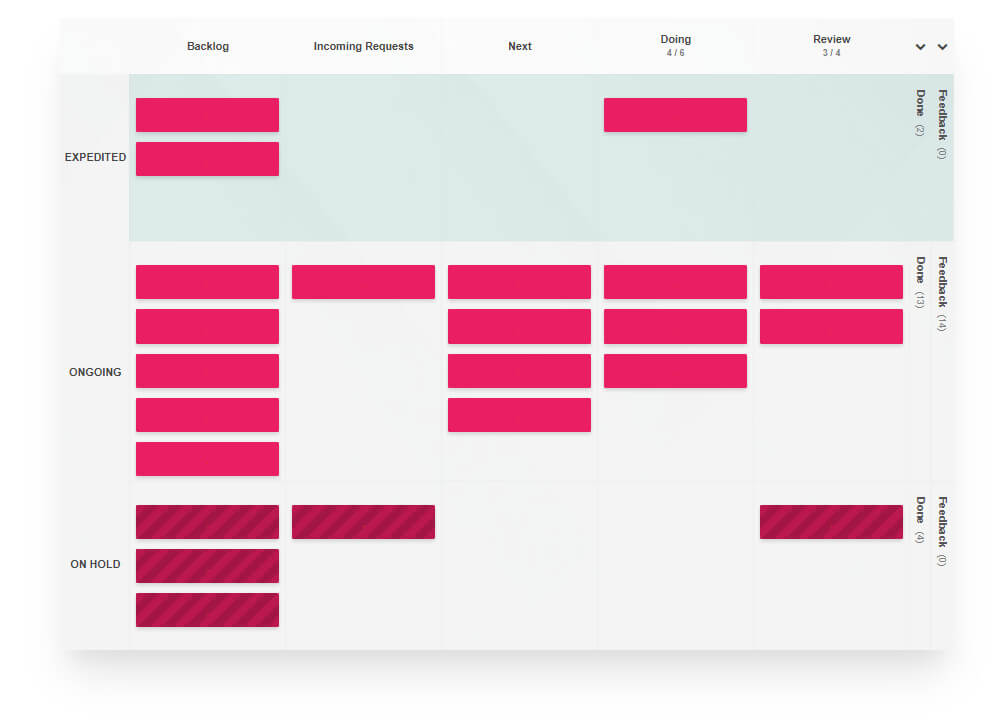
Kintone
Kintone streamlines your team’s workflows and gives you a centralized hub for maximizing collaboration and productivity. This platform tracks and organizes all your team’s data so nothing gets lost in the shuffle. With Kintone, you can condense even the most complex parts of your project into simple yet impactful processes.
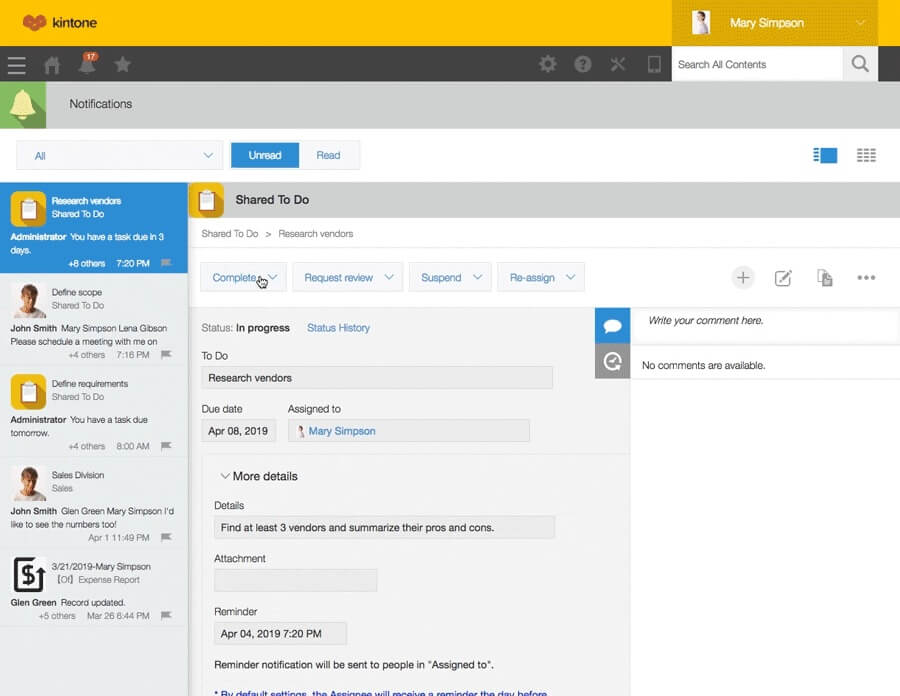
GanttPro
GanttPro builds on the concept of Gantt charts and adds advanced features for managing tasks, tracking your budget, and managing your team’s time. It turns complex project plans into easy-to-understand visual timelines while giving you a close view of project resources. It also integrates with other project management tools so you can bring the power of visual charts to the rest of your workflow.

Common challenges during project execution
Knowing which issues often come up during project execution can help you minimize setbacks. Here are some common challenges and ways to prevent or manage them.
1Scope creep
Scope creep happens when project requirements grow beyond the initial plan, and this can cause delays and budget issues. Clear project objectives and stakeholder communication during execution planning help lessen scope creep since you’ll have managed everyone’s expectations from the get-go.
2Lack of quality control
Results don’t always look exactly like the initial plans—and that’s normal! However, when quality control standards aren’t in place, your outcomes can deviate from your expectations. Routine quality checks throughout your project life cycle can help you maintain high standards and create successful project outcomes.
3Frequent change requests
Your stakeholders have high hopes for your project, but their input shouldn’t push your plans off track. When a client’s many requests start getting in the way of your timeline or budget, your project could face delays or exceed its scope. Although, yes, you want to accommodate client requests, you should balance them with project constraints and priorities.
4Communication gaps
If communication between (and within) teams and departments isn’t on point, timing, coordination, and task completion issues can pop up. Build clear communication channels and use collaboration tools that keep people in touch and working together. Fellow’s meeting guidelines drive effective, impactful communication that leads to productive team conversations and around-the-clock alignment on project goals.
From planning to execution with Fellow
When it comes to project meetings, quality is more important than quantity. Prioritize meaningful discussions without packing your team’s calendars with meetings. Fellow’s project meeting templates for just about every type of discussion unite your team around project objectives and the approaches you’ll take to achieve them.
Don’t forget to take advantage of Fellow’s AI features throughout the project execution process. With advanced AI meeting recordings, transcriptions, and summaries, Fellow can capture an accurate record of every key discussion and decision so everyone stays aligned.
With this powerful management software on your side, your project execution plan becomes more than an outline—now, it’s a realistic strategy for achieving powerful results.
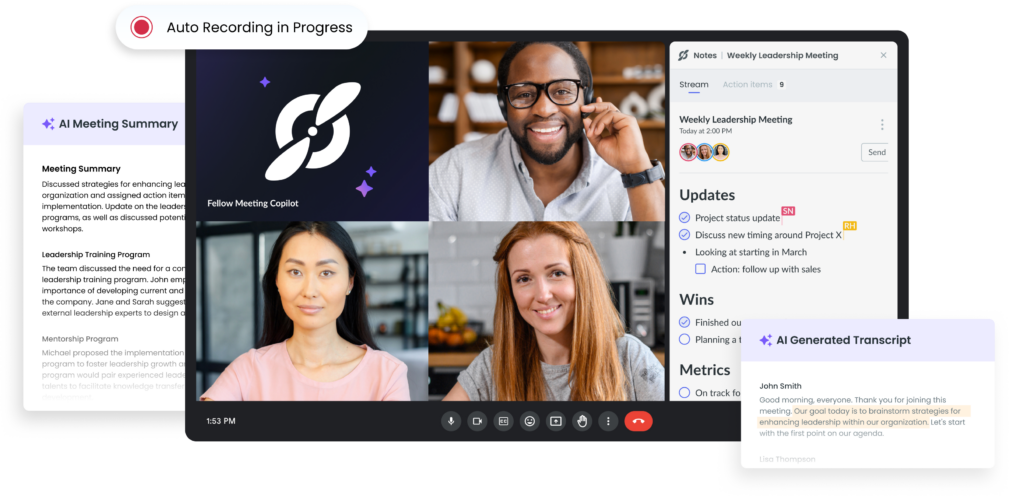




![How to Take the Best Meeting Notes: 8 Tips [+ Free Templates]](https://fellow.app/wp-content/uploads/2022/03/Tips-for-Taking-Meeting-Notes-That-Make-Sense.jpg)




